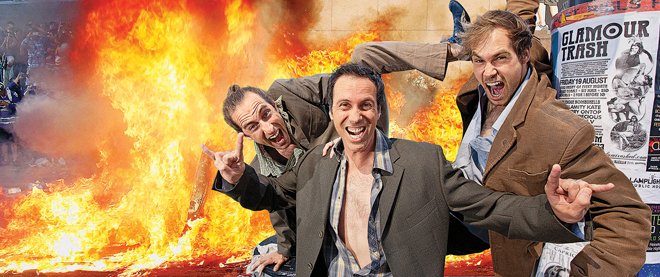Dance of the Stanley Cup rioters
A hockey fan choreographs the night Vancouver famously embarrassed itself
Photograph by Brian Howell; Photo Illustration by Sarah Mackinnon
Share

Stravinsky’s The Rite of Spring was, famously, a dance that started a riot, but until now, no one has seen the process reversed. Enter 41-year-old Edmond Kilpatrick—a Vancouver modern dance choreographer and fierce Canucks fan (though not the cruiser-toppling, Bay-looting kind of fierce) who was so disturbed by Vancouver’s Stanley Cup riot in June, he decided to dance about it. “The riot stole the entire hockey experience from me,” he says, “and the piece is a comment about what happened that night.”
The piece Kilpatrick is referring to is Party Boys, a three-man modern dance re-enacting the June 15 riot that followed the Vancouver Canucks’ 4-0 loss to the Boston Bruins in Game 7 of the Stanley Cup finals. “I thought we could congregate downtown and watch the game together,” Kilpatrick says, in reference to the throngs of Vancouverites who filled Georgia Street to watch the showdown on an enormous screen, “but obviously we couldn’t be trusted.” It’s hard to disagree with him. When hockey fans—and a few opportunistic anarchists—realized that their beloved Canucks would not be hoisting the Cup on home ice, storefronts were demolished, cars were vandalized and set on fire, and pictures of young men emerging from burning buildings clutching miscellaneous retail items—their Canucks jerseys pulled up to mask their faces—were more common than pictures of the Stanley Cup itself. Kilpatrick wants his piece—which runs August 10-12 on a 10-by-13-foot stage (the show is part of a larger production called Dances for a Small Stage at Vancouver’s Legion on the Drive)—to answer two questions: “Who were those guys and why did this happen?”
Kilpatrick answers the first one easily. “I want to depict instigators,” he says, “the guys riling everything up, and the guys getting sucked into it.” The piece is more of an abstract exploration of the riot, he explains (you won’t be seeing anyone in a Roberto Luongo jersey setting fire to a makeshift police car), with dancers exhibiting an “increased machismo” and “intensified aggression,” until a choreographed mosh pit breaks out and gives way to “mid-air body slamming,” accompanied by a funky and contemporary hard-driving jazz score. There are no props.
Kilpatrick is hesitant to give away too much information about the show before it opens, but he does divulge details about one character, who represents hockey fans physically removed from the riot—himself included. “Sane Vancouver: people sitting at home and watching the turmoil on TV.” This character, he elaborates, will weave in and out of the audience—a metaphor for complicity in the fan frenzy, but not necessarily the mayhem.
In fact, Kilpatrick was sitting at home watching TV when the idea for the show came to him. “I was in a sports sulk,” he says, “watching the other team with the Cup, when my wife came into the room and said, ‘You have to change the channel.’ ” When Kilpatrick saw on the news that his city had become a temporary Third World country, he knew he had to redo his current dance number (an unconventional “boylesque” piece in which he continually spills coffee on himself, removing his clothing one item at a time) with the riot theme. “Suddenly the boylesque thing didn’t seem so funny now that my city was on fire,” he says. “This is not something I would normally do,” says Kilpatrick, “but the riot pulled me in a direction.”
Still, it wasn’t an entirely different direction. “Dances for a Small Stage features a number of burlesque performers,” says the installation’s artistic producer, Julie-anne Saroyan, “and Edmond’s piece includes the removal of clothing in order to portray the evolution of the riot.” As each article of “regular street clothing” is removed by the dancers (the performers are never completely nude, Saroyan confirms), their movements become more erratic until a full-fledged dance riot erupts onstage, arguably the only place a full-fledged riot should ever erupt. That, at least, is the message Saroyan and Kilpatrick would like to convey. “It would be nice,” says Kilpatrick, “if everybody could congregate again next year, without the police.”